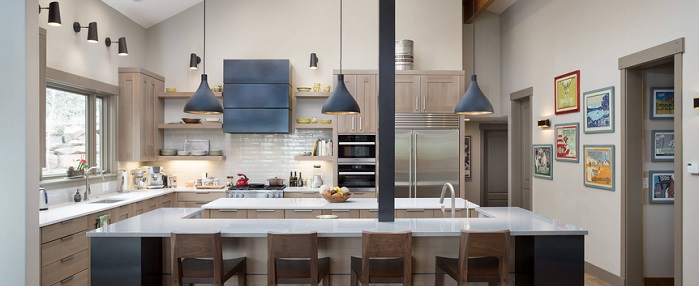It used to be that kitchens were places reserved solely for food preparation, off limits to guests and family members alike. Food was served at a set time in a separate room; whatever magic went into making it was a mystery to the people eating it. But the modern American kitchen is a very different one. With our busy schedules and a steadily increasing number of homes with both parents working, it can be hard to find time to share at all – let alone produce big multi-course dinners. This shift is reflected in the changing style of kitchens, which are larger and more open, inviting family and friends to participate in food preparation or simply gather everyone together while the cooks do their thing. Maybe the most important key to making the kitchen a hospitable place for guests and chefs a like, though, is the lighting.
Choose More Lights Rather Than Brighter Lights

Traditionally, kitchen lighting heavily favors utility, usually placing a single bright light or group of lights front and center in the middle of the ceiling. But to light the whole kitchen effectively, those lights have to be BRIGHT. Very bright lights wash out food and family alike, turning your kitchen into a glaring and inhospitable place. Instead, you want to mix several different types of gentler lights in different areas to get the most out of all of them. Recessed lights around the perimeter of the ceiling are a good place to start. But to make the most of your kitchen, you’re going to have to go a little further.
Use Your Island Light As A Stylish Centerpiece

Placing a chandelier or pendant light or other bar-style light over your kitchen island is a great way to add warm, inviting light to the place people are most likely to gather. You don’t want to hang the fixture too low (bumped heads are no fun). But it will feature prominently, so pick something that’s large enough to fill the space. The style you choose will go a long way toward setting the tone of your kitchen, so make sure that it meshes with the look you want. Right now, billiard lights are a popular choice for getting a simple-yet-bold look. But really any distinctive light can do the trick. Even if the bulk of the lighting in the kitchen is coming from other sources, this is going to be the one getting the attention, so it should get the most thought and attention in the design process.
Emphasize The Details Of Your Kitchen With Cabinet Lighting

Overhead lighting makes for a nice ambiance, but under cabinet lighting is vastly more useful for food preparation. Though you won’t be able to see the fixtures, round or bar-shaped lights beneath you cabinets will light up even the darkest parts of your counter, which is great for prep work. When you aren’t hard at work cooking, this type of lighting bring your counter tops out of the shadows. It can help highlight the features of your kitchen, especially your tile backsplash. And if you put them inside glass cabinets? They can illuminate your china or stemware and turn your storage space into an accent piece.
Supplement Problem Areas With Sconces

Though it might seem an odd place for them, wall sconces can work in the kitchen as well. Especially in a large space, it can be difficult for central lights to reach the edges of the room. Sconces can help bring a homey touch into the kitchen and make it a more inviting place to visit. In general, wall sconces should come in pairs and be mounted symmetrically on either side of a window, a piece of art, or a range hood to create a sense of balance.
Make Sure Your Lighting Matches Your Space

You also want to find lights that match and compliment your decor, and each other. Look for pieces that match your room in more subtle ways, echoing the architecture, furniture, or even the finishes in other parts of your kitchen – like your kitchen faucet or drawer pulls. This will help give the space unity and make it seem larger by drawing the eye smoothly between the different parts of the room. Gold and matte black are popular finishes right now, but consistency is the real key to making this look work.
Don’t Forget The Light Switch

The more different types of lights you layer, the richer and more complex the final effect will be. So don’t be afraid to overlap. That said, the more lights you want, the more important it is to pre-plan your lighting controls. You’ll need to decide ahead of time how you want to group your lights, and which ones you want to be turn on and off at the same time. Ditto for where you want to put the controls themselves. A huge panel that controls all your lighting can be a nice one-stop, but may look a little overwhelming and be less intuitive than more localized controls. Whatever you decide, including dimmer functionality is always a big plus, and can give you finer control over the level and intensity of your light.
If you and your family and friends spend a lot of time in your kitchen, adding the right lighting can completely revitalize the area. Just remember to think of your lighting in layers: primary lights to brighten the room, secondary lights to fill gaps in dark areas, decorative lights to add style, and small accents to bring out your kitchen’s natural beauty. This is one time where adding quantity will enhance your quality, too!


Pingback: 2013 Kitchen Design Trends - Top Ten Kitchen Trends For The New Year